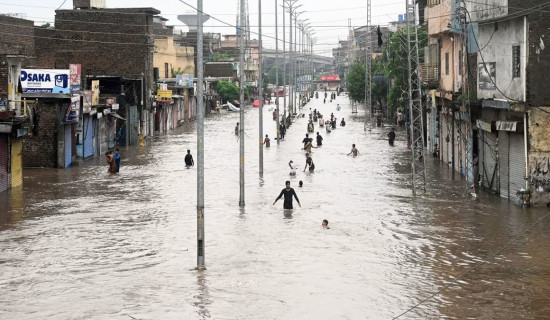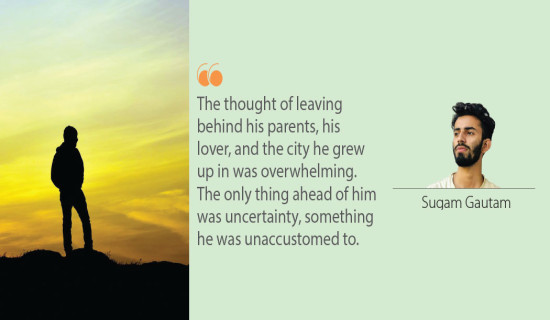- Friday, 18 July 2025
Min Bajracharya's Photographic Journey
July 17, 1987. It was when the first two photographs taken by Min Ratna Bajrachaya were printed in The Commoner, the first English daily of Nepal.
Interestingly, the photographs were also historical as they were related to a heinous crime orchestrated by powerful men during the Panchayat rule, in which journalist Padam Thakurathi was shot on the head in Kathmandu. One of the photographs was of the two handcuffed men who shot Thakurathi, and it was printed in the front page of the tabloid, and another was of the motorcycle used by the two to commit the crime, which was printed in the last page.
Now a successful professional photographer of Nepal, Bajracharya recalled how he happened to take the photographs with a camera which was gifted to him on his birthday on April 14, 1985 by a sister of one of his friends in Australia.
"As I had a camera then, Sichendra Bahadur Bista, one of my school friends of Indrachok, one morning challenged me whether I could dare to take a photograph. He posed the challenge only because he knew I had a camera. When I accepted the challenge, he said that the two men who hit Thakurathi with bullets were being brought to Charkhal Adda today," Bajracharya said.
He went to Charkhal, Dilli Bazaar, took black and white photographs and the next day two of them were printed in The Commoner. This is how Bajracharya happened to begin his career as a photojournalist.
"Thirty-seven years have elapsed since my first photographs were printed in newspapers, and I am still busy taking photographs," he said.
He took the photographs with the camera which he got as a birthday gift from Roma Roland, sister of his friend Navy Captain Lea Land Ponton in Australia.
He stayed in Australia with Ponton for six months from March 7 to September 12, 1985, mostly voyaging with him.
Also it was the first time when he met and talked to late King Birendra. Then Birendra was on a visit to Australia. After completing his Australia visit, Birendra arrived in Hong Kong on his way to Japan, and on the same day, Bajracharya reached Hong Kong while on his way home and he happened to meet the late king on September 10, 1985.
Then the students who went to study in the then USSR (Russia) in scholarship, used to bring cameras and sell them through local photo studio when they needed money. The black and white Russian camera were available for Rs. 600 to Rs. 700. Bajracharya bought one of them.
His second remarkable photograph was of the Dasarath Stadium stampede of March 12, 1988, in which 93 football fans were killed. This photograph was also published in The Commoner. Gopal Dash Shrestha, Editor of Commoner, after publishing the photo in his daily, sought permission from Bajracharya to supply the photo block to other media as well and gave Rs. 400 to him. Later, the photographs were also printed in Jhilko Magazine of Dr. Baburam Bhattarai.
By then many were familiar with his works. Impressed by his work, Nir Shah hired him to work in Telepatra of the Nepal Television. After working for nine months at Telepatra, he quit the job to participate in the People's Movement of 1990.
He also worked with Bimarsha Weekly for two years. While working at Bimarsha, the popular vernacular, which mostly gave spaces to the voices of the then banned Nepali Congress, he came in contact with Nepali Congress leader Ganesh Man Singh.
"Keshav Raj Pindali and Janardan Acharya of the Bimarsha Weekly used to frequently send me to Chaksibari, the residence of Ganeshman Singh, for his interview photographs. Because of my works, Ganeshman loved me, and took his several photographs in home and abroad," he said. "However, I had known P.L. Singh years before I reached Ganesh Man."
As Bajracharya came in contact with Ganesh Man Singh before the People's Movement, he also came close to Krishna Prasad Bhattarai. Bajracharya also took the photographs of Bhattarai's swearing-in ceremony held in the Narayanhity Palace after his appointment as interim prime minister in 1990.
However, Bajracharya did not work long with Bhattarai as he was removed from the team for publishing a photograph of a tiger skin which he saw in the Narayanhity Palace.
"While visiting the Narayanhity Palace with interim prime minister Bhattarai, I saw the palace decorated with animal skins and heads and I took their photographs and one of them was published. I had done that all to reflect the king's personality as well as anomalies," he said.
He also took a photograph of actress Manisha Koirala for Ruprang magazine published by the Bimarsha Weekly team. It was only after Koirala's photograph was printed in the cover story of Ruprang, Koirala did her first Nepali movie 'Feri Bhetaula', recalled Bajrachraya. Later, Koirala went to Mumbai and became a successful Bollywood actress.
Bajracharya's most impressive photograph was of the mass meeting of April 9, 1990, a day after the restoration of multiparty system through the successful People's Movement. In the photograph, an enthusiastic woman could be seen jumping up while chanting slogan of victory. This photograph was used widely by newspapers and magazines and even as a cover photograph in books. The woman seen in the exciting mood in the photograph was Durga KC, then a college student of New Baneshwor. She married a Nuwakot man and became Durga Thapa. A civil servant, she was also a trade union activist.
Although Bajracharya managed to left an impression in the photography in Nepal, he had not had any formal training in photography till 2001, when he participated in a formal training conducted by PANOS South Asia and the British Library in Kathmandu. All he did was through experiences and experiments.
Bajracharya organised a photo exhibition at Bajra Hotel in 1995, showcasing the photographs he had taken in his seven years' career. Noted Swiss geologist Tony Hagen had inaugurated the exhibition, appreciating the works of Bajracharya. This exhibition made Bajaracharya more popular.
Impressed by the photo exhibition, Kunda Dixit offered him a job for Himal Khabar Patrika. "Then Dixit was busy developing the concept of the magazine, and when he saw my archives, he called me," Bajracharya recalled. He worked for 15 years at the Himal Khabar Patrika. During his work at this magazine, he reached the wider audience.
Bajracharya, who worked with a black and white camera back in the late 1980s, now envies the technological development and Nepalis' access to advanced cameras. "Now parents can buy cameras worth Rs. 1 million for their children, but then we have to struggle even to buy a second hand Russian camera," he said. "Today, everyone has mobile cameras and myself take photographs using mobile phone."
He is fully satisfied with what he achieved from his long career in photojournalism. He lives a comfortable life in Kathmandu. Yet, he feels sad when he is unable to afford to pay the operation cost for his ailing knees. "I achieved everything in my long career, but failed to have a bank balance to manage the operation fees for my ailing knees," he said. Uric acid and an accident have resulted in the swelling of his both knees, and he walks with difficulty. Yet, 37 years after his first photographs were published, he is equally active in his career.
A dedicated and passionate photojournalist, Bajracharya has also another unfulfilled desire: Nude photography and exhibition. But he fears the society to resort to this. "Considering our social structure, taking nude photographs and putting them in display are impossible," he said.
(The author is Acting Managing Editor of this daily.)
















